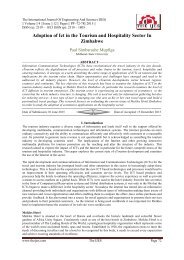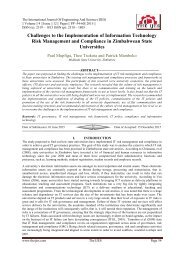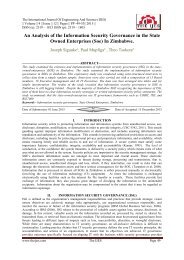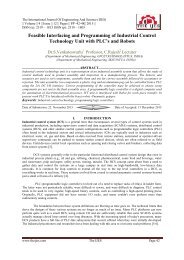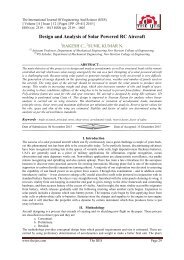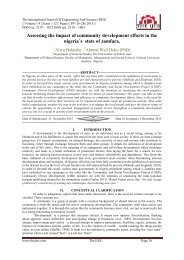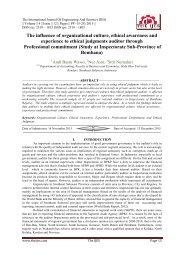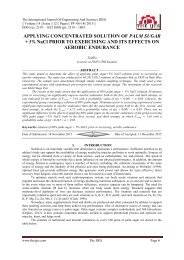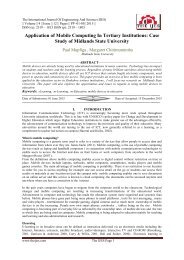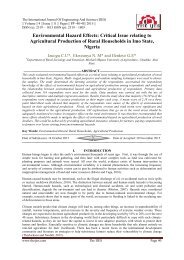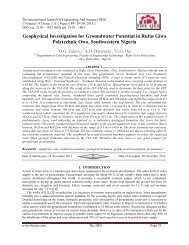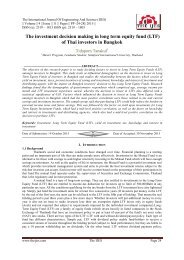o_19ee42smn1dhil304ke10al16b1r.pdf
You also want an ePaper? Increase the reach of your titles
YUMPU automatically turns print PDFs into web optimized ePapers that Google loves.
The International Journal Of Engineering And Science (IJES)<br />
|| Volume || 3 || Issue || 11 || Pages || 52-58 || 2014 ||<br />
ISSN (e): 2319 – 1813 ISSN (p): 2319 – 1805<br />
Parametric Optimization of Wire Electrical Discharge<br />
Machining (WEDM) Process Using Taguchi Method<br />
1, Vijaybabu.T , 2, Dr.D.V.Ravishankar , 3, Dr . Eshwara Prasad . Koorapati<br />
1, Department of Mechanical Engineering , Bharat Institute of Engineering and Technology ,Mangalpally,<br />
Hyderabad ,Telangana, India.<br />
2, Principal , TKR College of Engineering &Technology , Meerpet ,Hyderabad, Telangana, India<br />
3, Professor & Director of Evaluation , J.N.T.University , Hyderabad, Telangana, India<br />
--------------------------------------------------------ABSTRACT-----------------------------------------------------------<br />
Wire electrical discharge machining (WEDM) is a specialized thermal machining process capable of accurately<br />
machining parts of hard materials with complex shapes. Parts having sharp edges that pose difficulties to be<br />
machined by the main stream machining processes can be easily machined by WEDM process. Technology of<br />
the WEDM process is based on the conventional EDM sparking phenomenon utilizing the widely accepted<br />
noncontact technique of material removal with a difference that spark is generated at wire and work piece<br />
gap. This paper describes an optimum cutting parameters for Titanium Grade5 (Ti-6Al-4V) using Wire-cut<br />
Electrical Machining Process (WEDM). The response of Volume Material Removal Rate (MRR) and Surface<br />
Roughness (Ra) are considered for improving the machining efficiency. A brass wire of 0.25mm diameter was<br />
applied as tool electrode to cut the specimen. The Experimentation has been done by using Taguchi’s L25<br />
orthogonal array under different conditions like pulse on, pulse off, peak current, wire tension, servo voltage<br />
and servo feed settings. Regression equation is developed for the VMRR and Ra. The optimum parameters are<br />
obtained by using Taguchi method.<br />
KEYWORDS: Optimization of Process parameters, material removal rate ,surface finish, Taguchi method,<br />
WEDM.<br />
--------------------------------------------------------------------------------------------------------------------------------------<br />
Date of Submission: 28 October 2014 Date of Accepted: 15 November 2014<br />
--------------------------------------------------------------------------------------------------------------------------------------<br />
I. INTRODUCTION<br />
Electrical discharge machining (EDM) is a non-traditional, thermo-electrical process, which erodes<br />
materials from the work piece by a series of discrete sparks between the work and tool electrode immersed in a<br />
liquid dielectric medium. These electrical discharges melt and vaporize minute amounts of the work material,<br />
which are then ejected and flushed away by the dielectric. A wire EDM generates spark discharges between a<br />
small wire electrode and a work piece with de-ionized water as the dielectric medium and erodes the work<br />
piece to produce complex two and three dimensional shapes according to a numerically controlled (NC) path.<br />
Guitrau et al.[1] The main goals of WEDM manufacturers and users are to achieve a better stability and higher<br />
productivity of the WEDM process. Williams and Rajurkar et al [2] Wire electrical discharge machining<br />
manufacturers and users emphasize on achievement of higher machining productivity with a desired accuracy<br />
and surface finish. However, due to a large number of variables even a highly skilled operator with a state-ofthe-art<br />
WEDM is rarely able to achieve the optimal performance. An effective way to solve this problem is to<br />
determine the relationship between the performance measures of the process and its controllable input<br />
parameters. Rajurkar and Royo et al [3]1rrcInvestigations into the influences of machining input parameters on<br />
the performance of WEDM have been widely reported . Hocheng et al. [4] investigated the correlation between<br />
current and spark on-time with the crater size produced by a single spark of SiC/Al work materials. Qu et al.[5]<br />
have, through examination of literature, concluded that research has not been directed towards EDM<br />
applications in the area of newly developed engineering materials and the boundaries that limit the material<br />
removal rate (MRR). Hence, investigations were carried out to study the effect of spark on-time duration and<br />
spark on-time ratio, two important EDM process parameters, on the surface finish characteristics and integrity<br />
of the four types of advanced engineering material such as porous metal foams, metal bond diamond grinding<br />
wheels, sintered Nd-Fe-B magnets, and carbon-carbon bipolar plates.<br />
www.theijes.com The IJES Page 52
Parametric Optimization Of Wire Electrical Discharge…<br />
Scott, Boyina and Rajurkar et al [6] used a factorial design method, to determine the optimal<br />
combination of control parameters in WEDM considering the measures of machining performance as metal<br />
removal rate and the surface finish. The study concludes that discharge current, the pulse duration and the<br />
pulse frequency are significant control factors. Tarng and Chung et al [7] used a neural network model to<br />
estimate cutting speed and surface finish using input settings as pulse duration, pulse interval, peak current,<br />
open circuit voltage, servo reference voltage, electric capacitance and table speed. Trezise et al [8] suggests<br />
that fundamental limits on machining accuracy are dimensional consistency of the wire and the positional<br />
accuracy of the work table. The detailed section of the working region of the wire electrode is shown in Fig.1.<br />
It is evident from Fig.1 that it is absolutely essential to hold the wire in a designated position against the object<br />
because the wire repeats complex oscillations due to electro-discharge between the wire and work piece.<br />
Normally, the wire is held by a pin guide at the upper and lower parts of the work piece. In most cases the wire,<br />
once used, will be discarded. However, there are problematic points that should be fully considered in order to<br />
enhance working accuracy.<br />
Fig.1: Details of WEDM cutting Gap.<br />
The most important performance measures in WEDM are metal removal rate, work piece surface finish,<br />
and cutting width. Discharge current, pulse duration, pulse frequency, wire speed, wire tension, dielectric flow<br />
rate are the machining parameters which affect the performance measures. The gap between wire and work piece<br />
usually ranges from 0.025 to 0.075 mm and is constantly maintained by a computer controlled positioning<br />
system. The material removal rate (g/min) is calculated by weight difference of the specimens before and after<br />
machining. The surface finish value (μm) is obtained by measuring the mean absolute deviation, Ra, from the<br />
average surface level. In WEDM operations, material removal rate determine the economics of machining and<br />
rate of production. In setting the machining parameter, the main goal is to maximize MRR and SF (surface<br />
finish). In order to investigate the effects of various process parameters on MRR and SF and then to suggest the<br />
optimal process settings, statistically designed experiments are used in this study. The Taguchi method, a<br />
powerful experimental design tool, uses simple, effective, and systematic approach for deriving of the optimal<br />
machining parameters. Further, this approach requires minimum experimental cost and efficiently reduces the<br />
effect of the source of variation. The methodology uses Taguchi’s experimental design for setting suitable<br />
machining parameters in order to effectively control the amount of removed materials and to produce<br />
complicated precise components.<br />
II. EXPERIMENTAL DESIGN<br />
Proper experimental design significantly contributes towards the accurate characterization and<br />
optimization of the process. Here, the criterion for experimental design and analysis is to achieve higher VRR<br />
along with reduction in Surface Roughness. An orthogonal array for six controllable parameters is used to<br />
construct the matrix of five levels of controllable factors. The L25 orthogonal array contains 25 experimental<br />
runs at various combinations of six input variables. In the present study Table-1 represents various levels of<br />
process parameters and Table-2 represents experimental plan with assigned values.<br />
Table 1: Levels of Various Process Parameters<br />
www.theijes.com The IJES Page 53
Parametric Optimization Of Wire Electrical Discharge…<br />
S.NO Process Parameters Units I II III IV V<br />
1. Pulse On Μs 11 11 120 124 125<br />
2 6<br />
2. Pulse Off Μs 60 56 52 48 44<br />
3. Peak Current Amps 70 11 150 190 230<br />
0<br />
4. Wire Tension Kg-f 4 6 8 10 12<br />
5. Servo Voltage Volts 10 30 50 70 90<br />
6. Servo Feed mm/mi<br />
n<br />
42<br />
0<br />
84<br />
0<br />
126<br />
0<br />
168<br />
0<br />
210<br />
0<br />
Table 2 : Experimental plan with assigned values<br />
S.NO Pulse on μs Pulse Off μs Peak Current Wire Tension Kg-f Servo Voltage Servo feed mm/min<br />
Amps<br />
Volts<br />
1. 112 60 70 4 10 420<br />
2. 112 56 105 6 30 840<br />
3. 112 52 145 8 50 1260<br />
4. 112 48 185 10 70 1680<br />
5. 112 44 215 12 90 2100<br />
6. 116 60 105 8 70 2100<br />
7. 116 56 145 10 90 420<br />
8. 116 52 185 12 10 840<br />
9. 116 48 215 4 30 1260<br />
10. 116 44 70 6 50 1680<br />
11. 120 60 145 12 30 1680<br />
12. 120 56 185 4 50 2100<br />
13. 120 52 215 6 70 420<br />
14. 120 48 70 8 90 840<br />
15. 120 44 105 10 10 1260<br />
16. 124 60 185 6 90 1260<br />
17. 124 56 215 8 10 1680<br />
18. 124 52 70 10 30 2100<br />
19. 124 48 105 12 50 420<br />
20. 124 44 145 4 70 840<br />
21. 128 60 215 10 50 840<br />
22. 128 56 70 12 70 1260<br />
23. 128 52 105 4 90 1680<br />
24. 128 48 145 6 10 2100<br />
25. 128 44 185 8 30 420<br />
III. SELECTION OF MATERIAL<br />
Titanium alloys are now the most attractive materials in aerospace and medical applications. The<br />
titanium its alloys are used extensively in aerospace, such as jet engine and airframe components, because of<br />
their excellent combination high specific strength (strength to weight ratio) and their exceptional resistance to<br />
corrosion at elevated temperature. In the present work Titanium grade 5 (Ti6Al4V) is used as work piece<br />
material and brass wire is used as electrode material. The chemical composition of the material is shown in<br />
Table -3. The variable process parameters and fixed parameters are given in Table-4 and Table-5 respectively.<br />
Table 3: Chemical composition of Titanium Grade 5 Material<br />
N C H Fe O Al V<br />
0.0 0.08 % 0.015 0.40 % 0.20 % 6.75 % 4.5 %<br />
5 %<br />
%<br />
III. EXPERIMENTAL WORK<br />
The experiments were planned according to Taguchi’s L25 orthogonal array[9] . The experiments were<br />
carried out on ELECTRONICA UNDER CUT S 1 four axis wire cut EDM machine is as shown in Fig.2. The<br />
basic parts of the WEDM machine consists of a wire Electrode, a work table, and a servo control system, a<br />
power supply and dielectric supply system. The following Fig shows the ELEKTRA UNDER CUT S 1 of wire<br />
EDM. . Therefore, the width of cut (W) remains constant. The VMRR for each WEDM operation was calculated<br />
using Eq. (1). Surface Roughness (Ra) is measured by handy surf equipment.<br />
www.theijes.com The IJES Page 54
Parametric Optimization Of Wire Electrical Discharge…<br />
Fig.2: Wire cut EDM (CNC) is used for experimentation<br />
Table 4 : Processes parameters of ELCTONIKA ULTRACUT S 1 WEDM<br />
Control<br />
Units Symbol<br />
parameters<br />
Pulse On μs A<br />
Pulse Off μs B<br />
Peak Current Amperes C<br />
Wire tension Kg-f D<br />
Servo Voltage Volts E<br />
Servo Feed mm/min F<br />
Table 5: Variable and fixed parameters in WEDM<br />
Machining Working Range Fixed Parameters Value<br />
Parameters<br />
Pulse On 115-131 machine Composition of<br />
Ti6Al4V<br />
unit<br />
material<br />
Pulse off 63-45 machine unit Work piece thickness 25mm<br />
Peak<br />
current<br />
70-230 Ampere Wire electrode material Brass wire<br />
Ø0.25mm<br />
Wire<br />
0-15 kg-f Dielectric medium Distilled water<br />
tension<br />
Servo 0-99Volts Wire feed 8m/min<br />
Voltage<br />
Servo feed<br />
setting<br />
0-2100 mm/min Wire offset 0.00mm<br />
IV. RESULT AND DISCUSSIONS<br />
The effect of machining parameters on material removal rate and surface roughness in machining<br />
Titanium (Ti-6Al-4V) are studied. From the results it is observed that, the pulse, pulse and peak current are the<br />
most significant factors for the performance measures. The wire tension, servo voltage and servo feed settings<br />
are less significant on performance measure. The results are obtained by analyzed using S/N Ratios, Response<br />
table and Response Graphs with the help of Minitab software. Table 6 shows this experimental results then it is<br />
analyzed and obtained the optimum process parameters for MRR and Ra.<br />
Table 6 : Experimental results of output parameters<br />
Ru A B C D E F Cutting Rate Cutting time VMMR Ra μm<br />
www.theijes.com The IJES Page 55
Parametric Optimization Of Wire Electrical Discharge…<br />
n mm/min minutes mm3/min<br />
1. 112 60 70 4 10 420 0.16 121.46 1.355 1.18<br />
2. 112 56 105 6 30 840 0.55 33.24 4.952 1.24<br />
3. 112 52 145 8 50 1260 0.65 30.54 5.389 1.28<br />
4. 112 48 185 10 70 1680 0.72 29.21 5.635 1.31<br />
5. 112 44 215 12 90 2100 0.35 59.56 2.777 1.16<br />
6. 116 60 105 8 70 2100 0.36 60.21 2.733 1.20<br />
7. 116 56 145 10 90 420 0.30 67.42 2.441 1.25<br />
8. 116 52 185 12 10 840 1.35 15.02 10.959 1.52<br />
9. 116 48 215 4 30 1260 2.21 9.12 18.049 2.11<br />
10. 116 44 70 6 50 1680 1.88 11.40 14.439 2.03<br />
11. 120 60 145 12 30 1680 1.72 11.56 14.239 2.01<br />
12. 120 56 185 4 50 2100 1.64 12.15 13.548 1.93<br />
13. 120 52 215 6 70 420 1.82 11.40 14.439 1.86<br />
14. 120 48 70 8 90 840 2.35 7.41 22.214 2.89<br />
15. 120 44 105 10 10 1260 2.19 8.52 19.320 2.76<br />
16. 124 60 185 6 90 1260 1.47 13.56 12.139 1.29<br />
17. 124 56 215 8 10 1680 1.82 10.58 15.558 1.37<br />
18. 124 52 70 10 30 2100 2.74 7.11 23.151 2.45<br />
19. 124 48 105 12 50 420 2.45 8.03 20.499 3.01<br />
20. 124 44 145 4 70 840 1.73 11.25 14.632 1.54<br />
21. 128 60 215 10 50 840 1.95 10.06 16.362 1.62<br />
22. 128 56 70 12 70 1260 2.12 9.25 17.795 1.73<br />
23. 128 52 105 4 90 1680 2.35 8.34 19.737 2.25<br />
24. 128 48 145 6 10 2100 1.93 10.21 16.122 1.53<br />
25. 128 44 185 8 30 420 2.42 8.12 20.272 2.08<br />
VI. SELECTION OF OPTIMAL PARAMETER COMBINATION<br />
The Experimental results shows the effect of six process parameters on material removal rate and<br />
surface roughness.Fig-4 shows the effect of Volume Material Removal Rate for the pulse on, pulse off, peak<br />
Current and Servo Voltage. From this Fig.4, it was observed that the VMRR increased when the pulse on time<br />
was increased due to number of discharges within a given period of time increase. In Fig.6, it shows that with an<br />
increase of pulse on time the surface quality of the machined surfaces were decreased because under longer pulse<br />
time on the electrical sparks generate bigger craters on the surface of work piece. Fig.3 and 5 shows the graphs<br />
for the S/N ratios.<br />
Fig.3. Response graph for S/N ratios (VMMR)<br />
Fig.4. Response graph for means (VMMR)<br />
www.theijes.com The IJES Page 56
Parametric Optimization Of Wire Electrical Discharge…<br />
Fig.5. Response graph for S/N ratios (Ra)<br />
Fig.6. Response graph for means (Ra)<br />
In Taguchi Analysis the Volume Material Removal Rate versus Pulse on, Pulse off, Peak Current and<br />
Servo Voltage is carried out and average of each level is the parameter for raw data is given in Table 7 and<br />
average of each level in terms of S/N ratios are given in Table 8. Surface Rough versus Pulse on, Pulse off, Peak<br />
Current and Servo Voltage is carried out and average of each level is the parameter for raw data is given in<br />
Table 9 and average of each level in terms of S/N ratios and optimal parameter setting to obtain maximum<br />
Volume Material Removal Rate is given in Table 10. After observing all response graphs, Table 11 shows the<br />
Optimal Parameters Combination for VMRR and Ra.<br />
Table7 : Response table for means larger is better<br />
Level Pon Poff PC WT SV SF<br />
1 11.01 21.45 21.01 19.92 19.43 17.19<br />
2 17.12 23.49 20.1 21.22 23.1 21.84<br />
3 24.31 22.36 18.58 20.05 22.19 22.43<br />
4 24.47 18.63 21.25 20.01 19.05 22.2<br />
5 25.09 16.08 21.06 20.8 18.23 18.34<br />
Delta 14.08 7.41 2.67 1.3 4.88 5.24<br />
RanK 1 2 5 6 4 3<br />
Table 8: Response Table for Signal to Noise Ratios<br />
Level pulse On Pulse Off Peak Wire tension Servo voltage Servo feed<br />
Current<br />
1 4.022 14.288 15.791 13.464 12.663 11.801<br />
2 9.724 16.504 13.448 12.418 16.133 13.824<br />
3 16.752 14.735 10.565 13.233 14.047 14.538<br />
4 17.196 10.859 12.511 13.382 14.047 14.538<br />
5 18.058 9.366 13.437 13.254 11.862 11.666<br />
Delta 14.036 7.138 5.226 1.046 5.086 2.872<br />
Rank 1 2 3 6 4<br />
Table 9: Response table for means smaller is better<br />
Level Pon Poff PC WT SV SF<br />
1 -1.817 -5.274 -5.87 -4.886 -4.064 -4.94<br />
2 -3.959 -6.263 -5.777 -3.863 -5.713 -4.533<br />
3 -7.04 -5.2 -3.518 -4.408 -5.553 -4.884<br />
4 -5.21 -3.403 -4.053 -5.015 -3.566 -4.867<br />
5 -5.21 -3.097 -4.018 -5.064 -4.34 -4.012<br />
Delta 5.223 3.165 2.352 1.202 2.146 0.928<br />
Rank 1 2 3 5 4 6<br />
Table 10: Response Table for Signal to Noise Ratios<br />
Level Pon Poff PC WT SV SF<br />
1 1.234 1.914 2.056 1.802 1.672 1.876<br />
2 1.622 2.17 2.092 1.59 1.978 1.762<br />
3 2.29 1.872 1.522 1.764 1.974 1.834<br />
4 1.932 1.504 1.626 1.878 1.528 1.794<br />
5 1.842 1.46 1.624 1.886 1.768 1.654<br />
Delta 1.056 0.71 0.57 0.296 0.45 0.222<br />
Rank 1 2 3 5 4 6<br />
Table 11: Optimal Parameter Combination for MRR and Ra<br />
Process<br />
Optimum Level for VMRR Optimum Level for Ra<br />
Parameters<br />
Pulse On 128 112<br />
Pulse Off 48 60<br />
Peak Current 220 150<br />
www.theijes.com The IJES Page 57
Parametric Optimization Of Wire Electrical Discharge…<br />
Wire Tension 6 6<br />
Servo Voltage 30 70<br />
VII CONCLUSION<br />
In this research, three different analyses are employed to obtain the following goals. Evaluating the<br />
effects on machining parameters on volume material removal rate, evaluating the effects on machining<br />
parameters on surface roughness and presenting the optimal machining conditions. Taguchi Analysis determines<br />
the factors which have significant impact on volume material removal rate. Equations which correlate machining<br />
parameters with material removal rate is found by regression analysis, and the optimal setting is found by S/N<br />
ratio analysis. The present work was carried out by Taguchi analysis; further this work can be extended by<br />
considering any combination of fuzzy control, Grey relational analysis with Taguchi’s orthogonal array<br />
technique, response surface methodology techniques.<br />
REFERENCES<br />
[1]. Guitrau, E.B., 1991, Wire EDM-An Overview of Technology and Trends”, SME Technical Paper, MR 91- 519.<br />
[2]. Williams, R.E., Rajurkar, K.P., 1991, “Study of Wire Electrical Discharge Machining Surface Characteristics”, Journal of<br />
Materials Processing Technology, Vol. 28, pp.486-493.<br />
[3]. Rajurkar, K.P., Royo, G.F., R.F., 1989, “Effect of Control and Orbital Motion on Surface Integrity of EDM components”,<br />
Journal of Mechanical Working Technology, Vol.20, pp. 341-352.<br />
[4]. Hocheng, H., Lei, W.T., and Hsu, H.S., 1997, “Preliminary Study of Material Removal in Electrical-discharge Machining of<br />
SiC/Al”, Journal of Materials Processing Technology, Vol.63, pp. 813-818.<br />
[5]. Qu, J., Shih, A.J., Scattergood, R.O., 2002, “Development of the Cylindrical Wire Electrical Discharge Machining Process: Part<br />
I: Concept,Design, and Material Removal Rate”, ASME Journal of Manufacturing Science and Engineering, Vol. 124, pp. 702-<br />
707.<br />
[6]. Scott, D, Boyina, S., Rajurkar, K.P., 1991, “Analysis and Optimization of Parameter Combination in Wire Electrical Discharge<br />
Machining”, International Journal of Production Research, Vol. 29, No. 11, pp. 2189-2207.<br />
[7]. Tarng, Y.S., Ma, S.C., Chung, L.K., 1995, “Determination of Optimal Cutting Parameters in Wire Electrical Discharge<br />
Machining”, International Journal of Machine Tools and Manufacture, Vol. 35, No. 129, pp.1693-1701.<br />
[8]. Trezise, K.E., 1982, “A Physicist’s View of Wire EDM”, Proceedings of the International Conference on Machine Tool Design<br />
and Research, Vol.23, pp 413-419.<br />
[9]. A Hand Book on “Taguchi Techniques for Quality Engineering” by PHILLIP J. ROSS. 2005.<br />
[10]. Rajurkar K.P., Scott D, Boyina S., “Analysis and Optimization of Parameter Combination in Wire Electrical Discharge<br />
Machining”, International Journal of Production Research, Vol. 29, No. 11, 1991, PP 2189- 2207.<br />
[11]. Y. S. Tarng., Ma S.C., Chung L.K., “Determination of Optimal Cutting Parameters in Wire Electrical Discharge Machining”,<br />
International Journal of Machine Tools and Manufacture, Vol. 35, No. 12, 1995, PP. 1693-1701.<br />
[12]. J.Prohaszka, A.G. Mamalis and N.M.Vaxevanidis, “The effect of electrode material on machinability in wire electro-discharge<br />
machining”, Journal of Materials Processing technology, 69, 1997, PP 233-237.<br />
[13]. (A) Y.S. Liao, Y.Y. Chu and M.T. Yan, Study of wire breaking process and monitoring of WEDM, International Journal of<br />
Machine Tools & Manufacture, 37 (1997) pp. 555-567. (B) Y.S Liao , J.T.Huang, A study on the machining parameter<br />
optimization of WEDM, Journal of Material Processing Technology,71(1997) pp. 487-493<br />
[14]. Jose Marafona, Catherine Wykes., “A new method of optimizing MRR using EDM with Copper–tungsten electrodes”.<br />
International journal of Machine tools and manufacturing. Vol. 40, 22 June 1999, PP 153-164.<br />
[15]. Mustafa Ilhan Gokler, Alp Mithat Ozanozgu, “Experimental investigation of effects of Cutting parameters on surface roughness<br />
in the WEDM process”. International journal of Machine tools and manufacture. Vol. 40, 2000, PP 1831-1848.<br />
[16]. S.H.Lee, X.P Li, Study of the effect of machining parameters on the machining characteristics in electrical discharge machining<br />
of tungsten carbide, Journals of Material Processing Technology 115 (2001) pp.344-358.<br />
[17]. C. L. Lin, J. L. Lin, T. C. Ko, “Optimization of EDM process based on the orthogonal array with fuzzy logic and grey relational<br />
analysis method”. International journal of advanced manufacturing technology. Vol. 19, 2002, PP 271-227 .<br />
www.theijes.com The IJES Page 58



